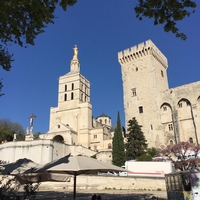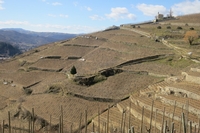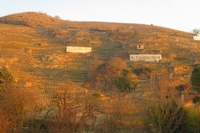AVIGNON, France – I’m halfway through a week involving tastings of more than 500 wines in both the northern and southern portions of the Rhône Valley, and the news is almost entirely good…so good as to be almost embarrassing.
Naturally, the news from France can’t be all good in a week that included the very bad burning and near destruction of Cathédrale Notre-Dame de Paris, though the prospects for successful rebuilding now look pretty promising. Another fly in the proverbial soup is the indisputable fact that a remarkable string of excellent vintages for the Rhône has coincided with an alarmingly even  ascent in average temperatures. This would turn from good vinous news to extremely bad news for the Rhône if the trend line doesn’t level off, even though vintners do have some counter-measures at their disposal.
ascent in average temperatures. This would turn from good vinous news to extremely bad news for the Rhône if the trend line doesn’t level off, even though vintners do have some counter-measures at their disposal.
But let’s get back on the upbeat. To find a bad vintage in the Rhône, you’d need to go all the way back to 2008. As for the intervening years, you could find some purists who are less enthusiastic about some years than others, but for the red wines that remain by far most important in both the north and south, 2009 and 2010 were fabulous; 2015 was great in the north and very good in the south; 2016 was stylistically marvelous everywhere; 2017 looks sensational in the north and excellent in the south, and 2018 shows wonderful promise based on the young wines I’m tasting (admittedly unfinished in most cases, but wonderfully packed with pure fruit).
Indeed, the last four vintages look so strong that wine lovers who didn’t stock up on the many great wines made in 2009, 2010 can simply laugh off what would have looked like a colossal blunder in almost any other vinous historical context.
I bought 2015 reds, though mostly from the north, as heat and dryness in that year produced many wines in the south with a lot of alcohol in relation to acidity. That problem was greatly reduced by the weather in 2016, which included a long end to the growing season with even daytime temperatures and cool nights, letting growers patiently await exactly the time they got the balance  of flavor components they desired in their grapes before picking them. The 2016s are “smaller” wines than the ‘15s, but also more harmonious in structure and pure in flavor. They’re easier to enjoy young, but are so balanced that they’ll last (and improve!) for years.
of flavor components they desired in their grapes before picking them. The 2016s are “smaller” wines than the ‘15s, but also more harmonious in structure and pure in flavor. They’re easier to enjoy young, but are so balanced that they’ll last (and improve!) for years.
Although 2017 was clearly hotter than 2016, the results look better to me at this point than in 2015, and I’m tasting the wines at exactly the same point in their development as when I was last here in April of 2017. I’ve still got a lot more wines from the south to taste before the week is over, but regarding the wonderful wines of Côte-Rôtie, Hermitage, Cornas, Saint-Joseph and Crozes-Hermitage, let me say this: The wines are fabulously generous without seeming overbearing, and though they are too big to fit everyone’s definition of “classic” in style, they will be among the most generous and delicious wines ever made in these appellations.
Probably closest to 2009 in general profile among recent vintages, the 2017s are (generally speaking, of course) extremely dark in color and very densely concentrated. They are packed with fruit, but importantly, the fruit us almost always pure in character rather than “cooked,” which is the risk in any warm growing season. As for balance, most show very pleasant freshness at this early juncture, and sufficient acidity is really the flip-side of the fact that the wines don’t taste “cooked” or “raisined” or “candied.” One last note of importance: The 2017 reds from the north are remarkable  in that these things just absorb oak like they were eating it for breakfast. Even producers whose wines are usually too oaky for my taste got the balance right in 2017, perhaps despite themselves, due to the great depth of fruit they were working with.
in that these things just absorb oak like they were eating it for breakfast. Even producers whose wines are usually too oaky for my taste got the balance right in 2017, perhaps despite themselves, due to the great depth of fruit they were working with.
My advice for consumers? If you didn’t buy the 2015s from the north when they were plentiful and a bit less expensive than they are now, you can laugh that off, too. The 2017s will be similar in style…probably just as good…and conceivably even better. But if you like fresher, more stylish Syrah from the north, don’t pass on the 2016s while waiting for the 2017s. They are wonderful as a group, and easy to enjoy even now. Moreover, some wines that are often rather wild and forbidding in their youth, like from Cornas for example, are just marvelous. They still have lots of intensity and power in 2016 due to baseline growing conditions in the appellation, but the growing season imparted a freshness and stylishness that they don’t display in many vintages…and may not display at all if the climate continues to warm in the decades ahead.
Sorry for that last downer. The overall report remains remarkably delicious, and I’ll publish dozens and dozens of specific tasting notes as well as a couple of columns in the months ahead.
1
